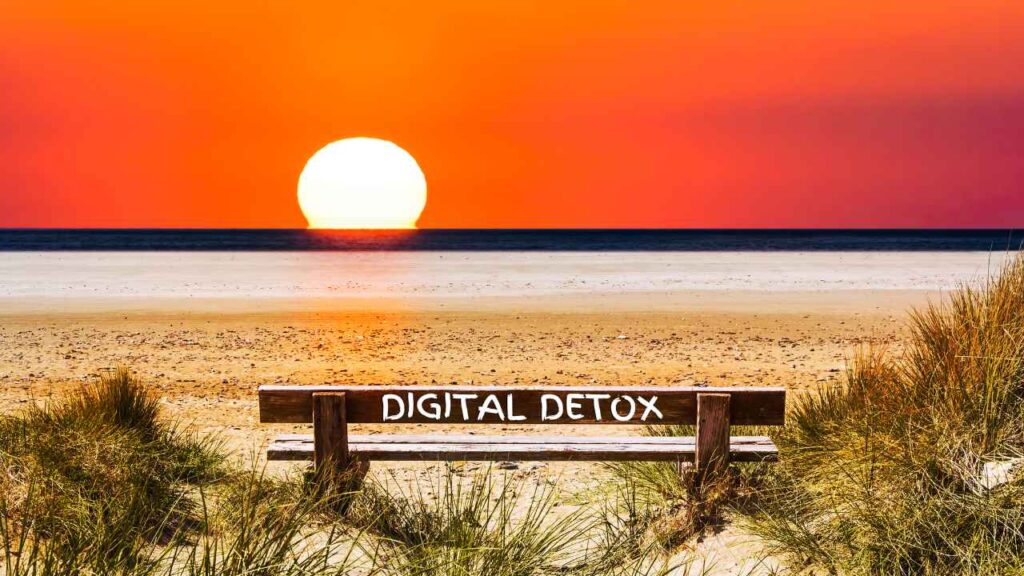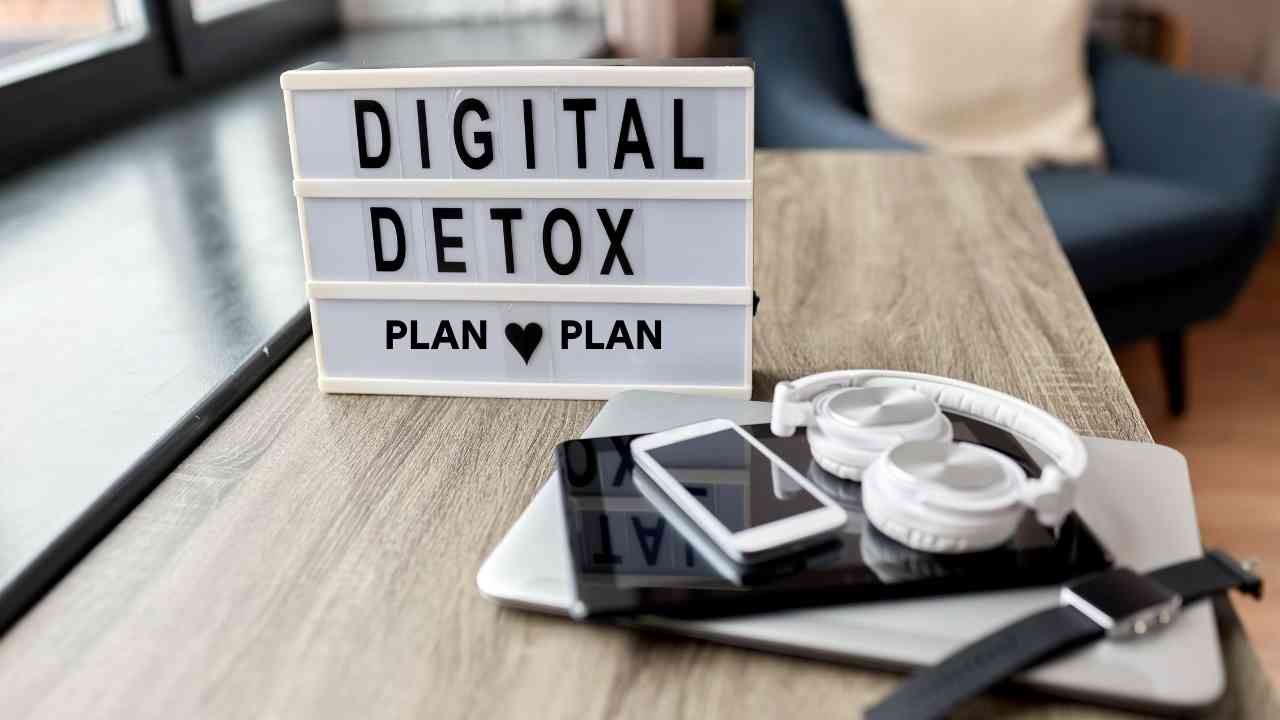Introduction
A Digital Detox Plan is more than just taking a break from your devices—it’s about reclaiming control over your life. In today’s fast-paced world, we’re constantly glued to our screens, whether we’re scrolling through social media, checking emails, or binge-watching shows. The endless notifications, buzzing alerts, and constant connectivity can leave us feeling drained and overwhelmed.
Have you ever felt the weight of being “always on,” unable to truly disconnect? It’s a problem many of us face, but the solution lies in taking a step back. Imagine a life where you feel more present, less stressed, and more in tune with yourself and the world around you.
This 7-day Digital Detox Plan is designed to help you reset your mind, recharge your energy, and rediscover balance. By the end of this journey, you’ll unlock the key to a happier, stress-free life. Let’s dive in!
Key Takeaways
- A Digital Detox Plan enhances mental clarity and well-being.
- Track your screen time to identify areas for improvement.
- Set clear boundaries for technology use.
- Declutter your devices for fewer distractions.
- Replace digital habits with offline hobbies and activities.
- Spend time outdoors to reduce stress and refresh your mind.
- Reflect daily on your detox progress.
- Reward yourself for sticking to the detox plan.
- Involve friends or family to stay accountable.
- Limit distractions using technology to help your detox.
What Is a Digital Detox?
A Digital Detox Plan is a deliberate decision to step away from electronic devices like smartphones, computers, tablets, and even televisions. It’s a chance to take a break from the constant connectivity that often consumes our lives. This planned disconnection is not about abandoning technology forever; instead, it’s about creating space to reset your relationship with your devices.
The goal of a digital detox is to reduce screen time and focus on improving your mental, emotional, and physical well-being. Too much time spent on screens can lead to stress, anxiety, sleep problems, and even a feeling of disconnection from real-world experiences. Taking a break allows you to regain balance, reconnect with yourself, and focus on what truly matters.
When you follow a Digital Detox Plan, you intentionally shift your energy from digital distractions to meaningful activities. Whether it’s spending quality time with loved ones, enjoying nature, or rediscovering a forgotten hobby, a detox helps you regain control over your time.
By the end of the process, you’ll likely feel refreshed, more mindful, and in charge of how you use technology. A digital detox isn’t just a break; it’s a pathway to a healthier, more intentional life.

Key Benefits of a Digital Detox
Taking a break from digital devices can have life-changing effects. Below, we’ve expanded on the top benefits of following a Digital Detox Plan, providing practical insights to help you understand why this is essential for your overall well-being.
1. Improved Mental Health
Constant notifications, emails, and social media updates can overwhelm your brain. Over time, this digital overload contributes to stress, anxiety, and even feelings of inadequacy, especially when comparing your life to others online.
By unplugging from your devices, you allow your brain to relax and reset. A study by the American Psychological Association revealed that more than 43% of adults who constantly check their phones feel stressed. With a Digital Detox Plan, you create mental breathing room, helping to reduce anxiety and improve overall mental clarity.
“Taking breaks from screens is like hitting the reset button for your mind.”
2. Better Sleep
Did you know that staring at screens before bed can disrupt your sleep? The blue light emitted by phones and computers suppresses melatonin, the hormone that helps regulate sleep. Poor sleep, in turn, leads to fatigue, irritability, and decreased productivity.
Limiting screen time, especially in the evenings, helps your body naturally prepare for rest. According to the Sleep Foundation, avoiding blue light exposure for at least one hour before bedtime can significantly improve sleep quality.
Table: Sleep Comparison – Before and After
| Before Digital Detox | After Digital Detox |
| Difficulty falling asleep | Easier, faster sleep onset |
| Frequent waking during night | Deeper, uninterrupted sleep |
| Tired and groggy mornings | Waking up refreshed |
3. Strengthened Relationships
Have you ever been in a room full of people, but everyone was glued to their phones? While technology connects us in many ways, it often creates distance in real-world relationships.
By following a Digital Detox Plan, you open the door to more meaningful, face-to-face connections. You’ll have time to engage in deeper conversations, strengthen bonds, and create memories that last. Research from Harvard University shows that close relationships are the biggest predictors of happiness and health. Taking a break from screens helps you nurture these bonds.

 UK Visitors – Start Your 7 day Paramount Trial!
UK Visitors – Start Your 7 day Paramount Trial!
4. Enhanced Productivity
Distractions from emails, texts, and social media notifications can make focusing on work or personal goals almost impossible. Studies reveal that it takes about 23 minutes to regain focus after an interruption. Imagine how much time is lost in a day!
When you limit screen time, you naturally minimize distractions. A Digital Detox Plan allows you to channel your energy into tasks that truly matter. You’ll notice a boost in efficiency, better time management, and a feeling of accomplishment as you tick items off your to-do list.
Table: Productivity Before vs. After a Detox
| Factor | Before Detox | After Detox |
| Hours spent on devices | 4–7 hours daily | 1–2 hours daily |
| Focus level | Easily distracted | Highly focused |
| Task completion | Often delayed | Completed on time |
5. Boosted Self-Awareness
Constant screen time can numb your ability to reflect on your own habits, emotions, and priorities. A Digital Detox Plan gives you the space to step back and evaluate how you’re spending your time. This period of self-reflection allows you to identify unhealthy patterns and make better choices moving forward.
For example, you might realize you’re spending too much time scrolling through social media or procrastinating important tasks. By creating healthier boundaries, you’ll feel more in control and aligned with your goals.
“A digital detox doesn’t just free up time—it gives you the clarity to live with intention.”
Why These Benefits Matter
The benefits of a Digital Detox Plan go beyond just turning off your devices. Each small change contributes to better mental health, deeper connections, and a more balanced life. Whether you’re looking to sleep better, strengthen your relationships, or improve focus, taking even a short break from screens can make a big difference.

7-Day Digital Detox Plan: Step-by-Step Guide
Starting a Digital Detox Plan might seem challenging, but with a structured approach, it becomes a manageable and transformative journey. Here’s a step-by-step guide to help you reset your relationship with technology and rediscover balance in just seven days.
Day 1: Evaluate Your Digital Habits
The first step is to understand how much time you spend on your devices and where that time goes. Use tools like Screen Time on iOS or Digital Wellbeing on Android to track your daily screen use. These apps break down your activities, showing you how much time you dedicate to social media, streaming, work, or gaming.
By seeing these numbers, you can identify patterns and areas where you might be overusing your devices. For instance, you might find that scrolling through social media takes up more time than you thought. Setting realistic goals for reducing this time is essential to begin your detox journey.
Table: Daily Average Screen Time Breakdown
| Activity | Average Time Spent | Goal Time |
| Social Media | 3 hours | 1 hour |
| Streaming Videos | 2 hours | 1 hour |
| Work Emails | 1.5 hours | 1 hour |
“The first step toward change is awareness.”
Day 2: Set Clear Boundaries
On Day 2, create rules to limit your device usage. Boundaries are crucial for balancing your digital life. Start with small but effective rules such as:
- No phones during meals to focus on family time.
- Avoid screens at least one hour before bedtime to improve sleep.
- Use “Do Not Disturb” mode during work hours for better concentration.
These rules not only reduce screen time but also help you reclaim moments that matter. For example, avoiding phones during meals encourages meaningful conversations and builds stronger relationships. Research by Common Sense Media shows that 48% of parents and 41% of teens feel disconnected when using devices during family time.
Day 3: Declutter Your Devices
A cluttered device can lead to unnecessary distractions and wasted time. On Day 3, focus on cleaning up your digital space to create a more organized and productive environment.
- Delete unused apps that take up space and steal your attention.
- Unsubscribe from irrelevant emails to reduce inbox overload.
- Organize files and folders on your phone or computer for easy access.
Taking these steps not only improves productivity but also makes it easier to stay focused on tasks that truly matter. For example, a clean inbox helps you prioritize important messages, saving you time and reducing stress.
Table 2: Decluttering Checklist
| Task | Action Steps | Time Required |
| Delete unused apps | Review all apps and uninstall extras | 10 minutes |
| Unsubscribe from emails | Use tools like Unroll.Me | 15 minutes |
| Organize files | Create folders for work, personal, etc. | 20 minutes |
“Decluttering your devices is like decluttering your mind—it gives you clarity and focus.”

 UK Visitors – Start Your 7 day Paramount Trial!
UK Visitors – Start Your 7 day Paramount Trial!
Day 4: Designate Screen-Free Zones
Expand your efforts by creating areas in your home where devices aren’t allowed. For example:
- Make the dining table a no-device zone to encourage family bonding.
- Keep phones out of the bedroom to improve your sleep quality.
- Create a cozy reading nook or relaxation area free from screens.
These physical boundaries make it easier to resist the temptation of reaching for your phone. Studies suggest that keeping devices out of the bedroom can lead to better sleep for 90% of people, according to the National Sleep Foundation.
Day 5: Engage in Offline Activities
On Day 5, fill the time you’d usually spend on screens with enriching offline activities. Choose activities that bring you joy and help you unwind, such as:
- Reading a book you’ve been meaning to start.
- Spending time outdoors, like going for a walk or gardening.
- Trying a new hobby like painting, knitting, or cooking.
Shifting your focus to these activities makes it easier to let go of digital distractions and reconnect with yourself. Outdoor time, for example, has been proven to reduce stress and improve mood significantly.
Table: Offline Activity Ideas
| Activity | Benefits | Recommended Time |
| Reading | Improves focus and creativity | 30 minutes |
| Gardening | Reduces stress and anxiety | 1 hour |
| Exercise | Boosts energy and mood | 30 minutes |
Day 6: Limit Social Media Usage
Social media is one of the biggest culprits of digital overload. On Day 6, take steps to limit your time on these platforms:
- Set app timers to restrict usage to 30–60 minutes daily.
- Log out of your accounts to avoid mindless scrolling.
- Consider a “social media cleanse” by taking a full-day break.
Taking control of your social media use helps you focus on real-life connections and activities. According to research by Statista, Americans spend an average of 2.5 hours daily on social media—time that could be better spent elsewhere.
Day 7: Reflect and Plan for the Future
As you reach the final day of your Digital Detox Plan, take time to reflect on your progress. Ask yourself:
- How do you feel compared to Day 1?
- What changes have you noticed in your mood, sleep, and productivity?
- Which habits or boundaries do you want to maintain moving forward?
Use this day to create a sustainable plan for balancing screen time in the long term. For example, you might decide to implement a weekly “digital-free day” or continue keeping phones out of the bedroom.
Table: Progress Reflection Table
| Category | Before Detox | After Detox |
| Screen Time | 6+ hours daily | 2–3 hours daily |
| Sleep Quality | Interrupted and poor | Deep and restful |
| Stress Level | High | Significantly reduced |
“Reflecting on progress helps solidify positive changes for the future.”

 UK Visitors – Start Your 7 day Paramount Trial!
UK Visitors – Start Your 7 day Paramount Trial!
Tips for a Successful Digital Detox
Making the most out of your Digital Detox Plan requires a bit of strategy and commitment. To help you stay on track and make your detox more enjoyable, here are some helpful tips:
1. Involve Friends or Family
Detoxing is easier when you’re not doing it alone. Having someone to share your journey with can help keep you accountable and make the process more enjoyable. You could set up a family detox challenge or ask a friend to join you. Not only will you have each other for support, but you can also share experiences and tips along the way.
Doing a digital detox with others can also encourage face-to-face interaction, which strengthens relationships and improves emotional well-being. Whether it’s enjoying a meal without distractions or going for a walk together, having someone else detox alongside you helps you stay motivated.
Research shows that social support is key to successfully sticking with lifestyle changes, especially when the change feels challenging. So, don’t hesitate to involve your loved ones in your Digital Detox Plan!
2. Use Technology to Limit Technology
Ironically, technology can be a helpful tool to assist in your digital detox. Apps like Focus@Will, Freedom, or Forest can help block distracting websites and apps, so you’re not tempted to check your phone. These tools help you stick to your detox plan without feeling like you’re fighting against technology the whole time.
For example, Focus@Will provides focus-enhancing music designed to help you concentrate, while Freedom allows you to block apps or websites for a set period of time. By using technology to limit technology, you’re setting yourself up for success. This way, you’ll be less likely to fall back into old habits and can spend your time more productively.
In fact, studies show that limiting distractions can improve productivity by up to 40%, making it easier to focus on the important aspects of your life, like self-care or quality time with loved ones.
3. Reward Yourself
Successfully completing a digital detox is an accomplishment worth celebrating! After each day or at the end of the full detox, reward yourself for sticking to the plan. Whether it’s enjoying a special meal, reading a new book, or spending an afternoon on a fun hobby, rewards help reinforce the positive behavior you’ve adopted.
Celebrating small wins can also keep you motivated throughout the detox process. For instance, if you made it through Day 1 without checking social media during meals, treat yourself to a nice dessert or a relaxing bath. These rewards act as positive reinforcement and make it easier to stick with the detox long term.
Studies in behavioral psychology show that rewarding yourself for good behavior helps increase the likelihood that you’ll repeat that behavior in the future. So, remember to celebrate the little victories during your Digital Detox Plan, and let them fuel your motivation for success!

How to Maintain Digital Balance After the Detox
Successfully completing your Digital Detox Plan is a huge achievement, but the key to lasting benefits is maintaining balance in your digital habits moving forward. Here are some effective strategies to help you stay balanced and avoid slipping back into old habits:
1. Schedule Regular Detox Days Each Month
Just because your Digital Detox Plan is over doesn’t mean your need for breaks is. To keep the benefits flowing, schedule regular detox days each month. These can be simple, such as taking a full day off from screens or setting specific hours where you unplug completely. By scheduling these regular breaks, you can prevent burnout and create a consistent routine for digital health, ultimately helping you maintain long-term balance.

 UK Visitors – Start Your 7 day Paramount Trial!
UK Visitors – Start Your 7 day Paramount Trial!
2. Practice Mindfulness During Screen Time
Being mindful doesn’t just apply to your off-screen activities; it’s equally important during screen time. Practicing mindfulness while using devices helps you be aware of how much time you’re spending on screens and how it’s affecting you. Instead of mindlessly scrolling or binge-watching, focus on being present and intentional with your digital interactions.
When you use technology, try these mindfulness tips:-
- Take regular breaks to stretch or walk around.
- Use apps that promote focus, like Forest or Focus@Will, to stay productive.
- Be conscious of your emotional state while using social media or checking emails.
Mindfulness during screen time helps prevent technology from taking over your life. It allows you to engage with your devices in a healthy, balanced way, rather than mindlessly reacting to every notification. Over time, this habit builds a strong foundation for maintaining your digital balance.
3. Regularly Assess and Adjust Your Habits
Digital habits can change over time, and it’s important to periodically reassess your relationship with technology. Are you spending too much time on social media again? Is work email starting to take up more of your free time? Regularly assessing and adjusting your habits helps ensure that you stay aligned with your detox goals.
Here’s how to assess your habits:-
- Track screen time using apps like Screen Time or Digital Wellbeing.
- Evaluate your emotional response to technology—do you feel overwhelmed or stressed by it?
- Set new limits or rules if you notice any areas where you’ve fallen back into old habits.
By making this a regular practice, you can maintain the healthy habits you cultivated during your detox and avoid slipping back into tech overuse. This continual evaluation ensures that you stay balanced and mindful of how technology impacts your daily life.

 UK Visitors – Start Your 7 day Paramount Trial!
UK Visitors – Start Your 7 day Paramount Trial!
FAQs (Frequently Asked Ques)
FAQs Session 1
A proper digital detox starts with setting clear goals, like reducing screen time or improving mental health. Begin by identifying your biggest distractions, such as social media or streaming platforms. Create a schedule to limit usage, such as “no screens an hour before bed” or “device-free meals.”
An example of a digital detox plan includes:
Day 1: Track and evaluate your screen time.
Day 2: Set boundaries, like no devices during meals.
Day 3: Declutter your devices by deleting unnecessary apps.
Day 4: Replace digital activities with offline hobbies like hiking or journaling.
Day 5: Schedule device-free time, such as from 8 PM to 8 AM.
Day 6: Spend time in nature to reduce stress.
Day 7: Reflect on the detox experience and adjust your habits.
The 30-day digital detox challenge involves gradually reducing your dependency on technology over a month. Each week focuses on specific goals:
Week 1: Limit social media usage and track time spent online.
Week 2: Remove non-essential apps and create device-free zones.
Week 3: Engage in tech-free activities like reading or meditation.
Week 4: Reflect on the benefits and set sustainable boundaries for long-term balance.
A digital detox typically includes:
Limiting screen time by setting daily usage limits.
Taking breaks from social media and emails.
Engaging in offline activities like exercising or pursuing hobbies.
Practicing mindfulness during technology use.
Setting device-free zones or times to create healthier habits.
Yes, digital detox is safe and highly beneficial for mental and physical well-being. It helps reduce stress, improve sleep quality, and enhance focus.
FAQ Session 2
The 21-day detox focuses on breaking unhealthy digital habits over three weeks. The idea is that it takes around 21 days to form a new habit. This detox involves reducing screen time, avoiding excessive social media use, and replacing digital activities with healthier alternatives like reading, yoga, or spending time outdoors.
Exiting a digital detox should be gradual. Reintroduce technology in small, mindful increments. For example, check emails twice a day instead of constantly. Limit social media time to 30 minutes per day and avoid binge-watching. Stick to the healthy boundaries you established during the detox, such as no screens during meals or before bedtime, to maintain balance.
A digital detox is hard because technology is deeply ingrained in our lives. Notifications, social media, and entertainment create instant gratification, which can feel addictive. Additionally, many people rely on technology for work, communication, and leisure, making it challenging to disconnect. Overcoming this requires intentional effort, clear goals, and alternative activities to fill the gap.
The term “digital detox” was popularized in the early 2010s as technology usage surged. While it’s unclear who specifically coined it, digital detox retreats and programs began emerging around this time to address the growing need for people to unplug and reconnect with real life.
The duration of a digital detox depends on your goals. A short detox can last 24-48 hours, while a more impactful one might last a week or even 30 days. For beginners, starting with a weekend detox is manageable. Gradually extend the duration as you adjust to reduced screen time. The key is consistency and making sustainable changes.







